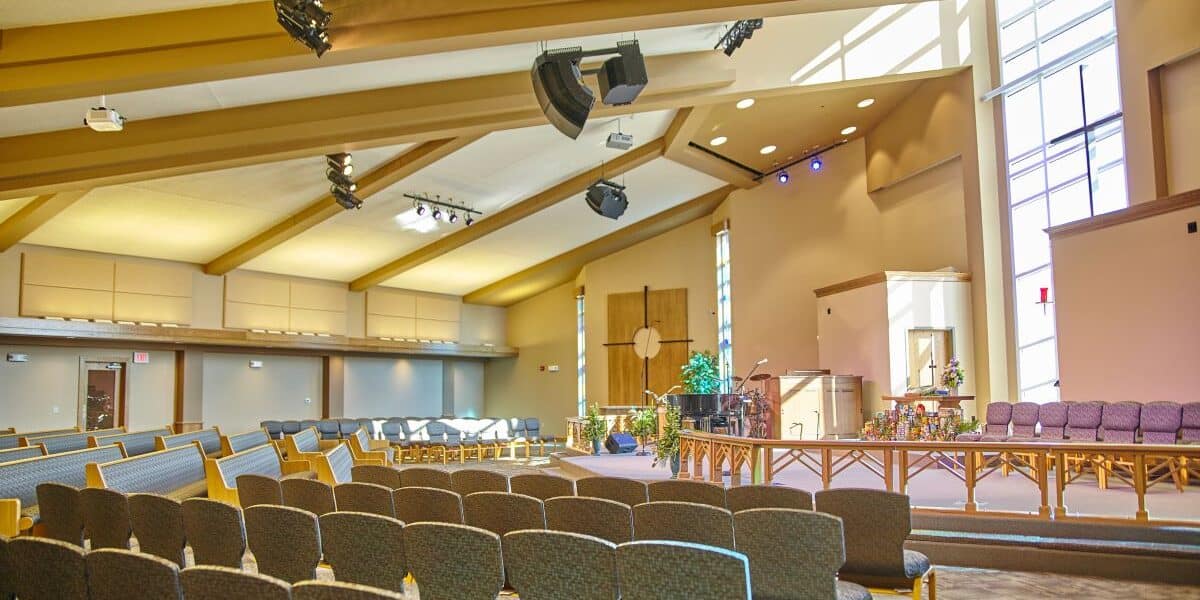The transformative power of dynamic lighting is not just reserved for grand theaters. Smaller spaces like the community church or multi-purpose room also have the potential to radiate dramatic lighting, rivaling even the most extravagant houses of worship. But achieving this transformative effect requires more than just hanging a few lights; it demands meticulous planning, efficient control systems, and reliable equipment.
Let’s explore the journey of upgrading stage lighting and illuminate the path to captivating events.
Dependability Is Key
The heart of any successful lighting upgrade lies in the reliability of the equipment. A lighting failure during an event not only disrupts the flow, it draws unwanted attention to the technical team, detracting from the message. To avoid such mishaps, it’s crucial to invest in equipment from reputable manufacturers, backed by a team of technicians who stand behind their work with long-standing tradition.
A qualified U.S.-based technical support team available via email, chat, and phone with a deep understanding of the systems will also be a big benefit to your organization, whether installing a new lighting system or upgraded equipment. Configuring a top-notch system can often require a bit of assistance in set-up to run seamlessly for decades, so installation instructions written and supported by the English-speaking designers is vital.
Crafting a Lighting Plan
Before delving into the journey of upgrading your stage lighting, it’s crucial to define your congregation’s needs and requirements. This entails evaluating aspects like the functionality and user-friendliness of necessary equipment such as lighting consoles, signal converters, dimmers, as well as architectural and theatrical stage lighting elements.
Theatrical vs. Architectural Lighting
The distinction between theatrical and architectural lighting lies in their respective functions within performance spaces. Theatrical lighting is designed to enhance the stage environment, supporting the narrative, mood, and focal points of a performance.
In contrast, architectural lighting focuses on illuminating the overall house, emphasizing aesthetics and functionality. It enhances the architectural features of the venue, provides ambient lighting, and ensures audience safety.
Choosing the Right Lighting Console and House Light Controls
The lighting console is the heart of any stage lighting system, dictating the ambiance and mood of the event. Cutting corners on the console can lead to disastrous consequences, as cheaply made in China boards are known for their limited life span, a failing that can steal the spotlight in a most embarrassing way.
Fixed installations have the choice between programmable and manual lighting consoles. While programmable units like the IQ512M are feature rich, offer versatility, and are ideal for venues looking to preprogram lighting cues, manual options like the Tech Master provide the simplicity and feel of old school consoles.
Architectural light controls are another easy way to upgrade light in spaces where house lights are needed possibly in addition to stage lights. The HLC product line has an attractive finish and can be mounted in standard wall switch boxes to easily blend into any house of worship operating independently of or in conjunction with DMX controls.
If you’re looking for a portable set-up, and the steadfast reliability of a proven American made lighting console, a product like the SceneMaster 8 would be a great choice. The SceneMaster 8 is an easy-to-use DMX console with eight dimmers built in. It features 12 control channels with bump buttons that can be soft patched to a full DMX universe of outputs and requires just two wall outlets for power on the go.
All recommended consoles work without the use of unreliable computer hardware or software, eliminating that dreaded operating system “updating” or never-ending start-up screen during your precious event.
Selecting Dimmers
Incandescent stage lights are controlled by dimmers, such as a Shoebox Dimmer. While LED based theatrical lighting instruments receive DMX directly, incandescent instruments or architectural lights with replaceable bulbs use phase-controlled power from dimmers that convert DMX and/or 0-10V control signals to the required power thus controlling brightness.
Signal Converters
For stage lighting, there is one primary lighting control signal: DMX-512. Digital Multiplex (DMX) is the industry standard for controlling theatrical lighting and effects. It allows for precise control over each light fixture, enabling dynamic changes in color, intensity, and movement. DMX works by sending digital signals from a controller to individual fixtures, allowing for complex lighting designs and sequences. It’s highly versatile and commonly used in professional settings.
Many congregations do not have DMX only systems and rely on 0-10V (Theatrical or Architectural) or phase control for equipment compatibility, cost constraints or historical reasons. However, upgrading to DMX opens a world of possibilities in terms of lighting control and creativity. Fortunately, there’s a solution for integrating different signals into a lighting system upgrade: Signal Converters.
Converters translate DMX signals into analog voltages compatible with 0-10V fixtures, enabling users to incorporate those lights into exceptional designs. There’s also the MTX-HTL, which converts Theatrical 0-10V to Architectural 0-10V (yes, they are different and not entirely compatible).
Choosing Lights
Once you’ve figured out which lighting controls and converters are needed, it’s time to think about individual lights and calculate which are generally wanted for your events. A three-point lighting system, as the term suggests, is one that uses lights in three distinct positions to adequately light each person on stage. The key light is the primary light source, the fill light is used to fill shadows, and the backlight creates a rim of light around each performer.
Let There Be…
Lighting diagrams can be useful at this point in the process and will allow your team to be on the same page as you discuss the upgrade of your systems. When it’s time to bring the lighting upgrade to life, inspired leadership, planning, and team communication are key to success. Mapping out setups through drawings facilitates coordination among the lighting crew, religious leaders, and performers, streamlining the planning and execution of the process to ensure a simple transition.
Lighting the Way Forward
Upgrading lighting systems to make a lasting impression requires careful planning, communication, and the right choice of equipment. By understanding lighting needs, as well as selecting reliable and well-supported equipment backed by long standing companies, even small religious spaces can leave a lasting impression on congregations for decades to come.
With the right lighting in place, the stage becomes a canvas for the divine message, illuminating the path to unforgettable performances and spiritual experiences.
Rich Howe is the lead design engineer and owner of Dove Systems, which has been serving and standing beside houses of worship for over 40 years, www.DoveSystems.com. The gold standard in religious lighting equipment, each control is made by hand, by skilled American technicians.












